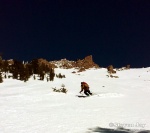 |
| The Northern Bridgers with a fresh coat of September snow |
September provided the mountains around Bozeman with their first seductive layer of white since last season. Few ranges look as comely as the Spanish Peaks’ northern flanks in the sultry colored half-light of the morning. I looked on wistfully each day on the bike ride to work, weighing the merits of long approach for fresh turns against the core shots that would inevitably result from the thin early season snowpack.
Patience
was rewarded the following week, when a snowstorm dumped upwards of a foot in
the high mountains around town. The northern Bridgers were socked in and I was
able to finagle my way out of work Friday — under the pretense that the
adventure get written up for the Chronicle’s
Outdoors section — and hit the mountains with my friend Tyler.
 |
| Ready to rock |
Trust in the two SNOTEL sites in the Bridgers
led us first to Ross Peak, where an alleged seven inches waited. By the time we
reached the trailhead, however, it was clear that the meadows we originally
planned to ski didn’t have enough coverage to make us forget about the rocks
underneath.
We careened back down the access road and headed to Sacajawea to ski a couloir that Tyler knew about. It had a pretty quick approach and dropped into Frazier Basin. Not only that, but in the small pullout area there was a Subaru containing the wild-eyed teleskier I met skiing Sacajawea in June and while skiing the Blaze in July. Since we were planning to ski the same area, the two of us and the teleskier — his name is also Jason — and his dog, Pepper, trekked up together.
 |
| Jason and Pepper assessing the conditions |
We made it to the top of a distant knob in good time. Snow conditions were excellent there, with thigh-deep light, soft snow. The deep areas were created by wind, which had apparently blown most of the snow out of a chute Jason knew about and had hoped to ski. Instead, Tyler led us over to a neighboring chute farther west that turned out to have the best coverage of what we could see.
The first dozen turns were incredible. A brief straight-line to pick up speed. Quick turn to test out the snow. Then a few turns in the drifted gully created by the steepening slope. The 10 inches of cold smoke kicked up around our shins and aroused thoughts of true winter.
 |
| A fine start to the run |
Those thoughts were quickly bedded back down, however. The light snow only concealed the rocks with its beauty rather than offer a loving, supportive barrier to shield P-Tex from jagged stone. As soon as we reached the heart of the slope, it was obvious the coverage was no longer enough to barrel downhill. But we agreed to billy goat our way to the bottom in the interest of traversing the bowl and scoping out other lines before skinning back to the knob.
Talk turned a bit to how the early season snowfall could affect the winter’s snowpack, but all apprehension was outweighed by the fun of those turns at the top. There’s little you can do about the weather but enjoy it when it comes. I suppose we could cross our fingers and hope the storms come with some regularity, which they have so far this fall. But if the last several years have shown anything, it’s that storms are going to arrive when they will and it likely won’t be with any dependable consistency.
“The storms are acting what I call ‘more bipolar,’ too,” Doug Chabot, director of the Gallatin National Forest Avalanche Center, said in Porter Fox’s new book, DEEP: The Story of Skiing and the Future of Snow. “We get these crazy swings. We might get a big snowstorm that feels like winter, followed by unseasonable warm, sometimes record-breaking temperatures. They have this manic feeling to them. We can’t just settle into winter anymore.”
Fox was kind enough to provide an advance copy of his book and will join the Seneca podcast this week, discussing both the book and some of his experiences around southwest Montana and Jackson, Wyo. He’s familiar with the area, even writing about skiing out the south end of Bridger Bowl for Powder in March.
Several lines stood out while we trekked parallel to the southern edge of Frazier Basin. A mental checklist was made for later this season when a big dump — hopefully! — will fill in and prevent skiers from hitting the bottom or any weak layers nefariously left over from these early season storms.
Finally back atop the knob, Tele Jason sent it down the low-angle drainage back to the car first. It was a smooth return with only a couple telltale dinks here and there from rocks while crossing the meadows. The dinks ended up turning my skis into one of the most mangled pair of boards a ski tech at the Round House had ever seen. It was hard to worry too much about that with a beer in hand and a snow covered mountain range in the background, and one more month until hitting 12 consecutive months of skiing.
 |
| Skiing back to the car is vastly underrated |
-- Jason Bacaj




























